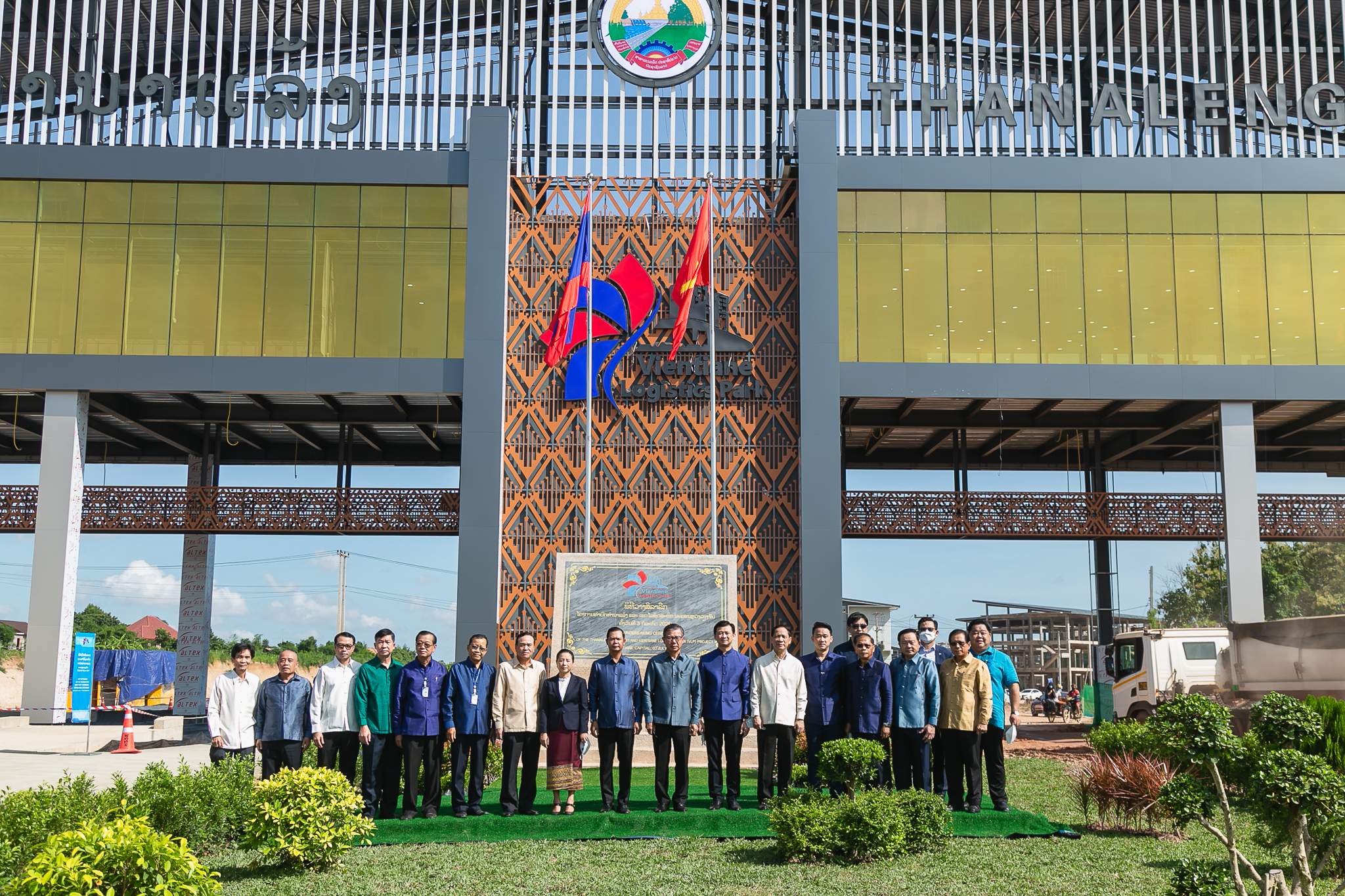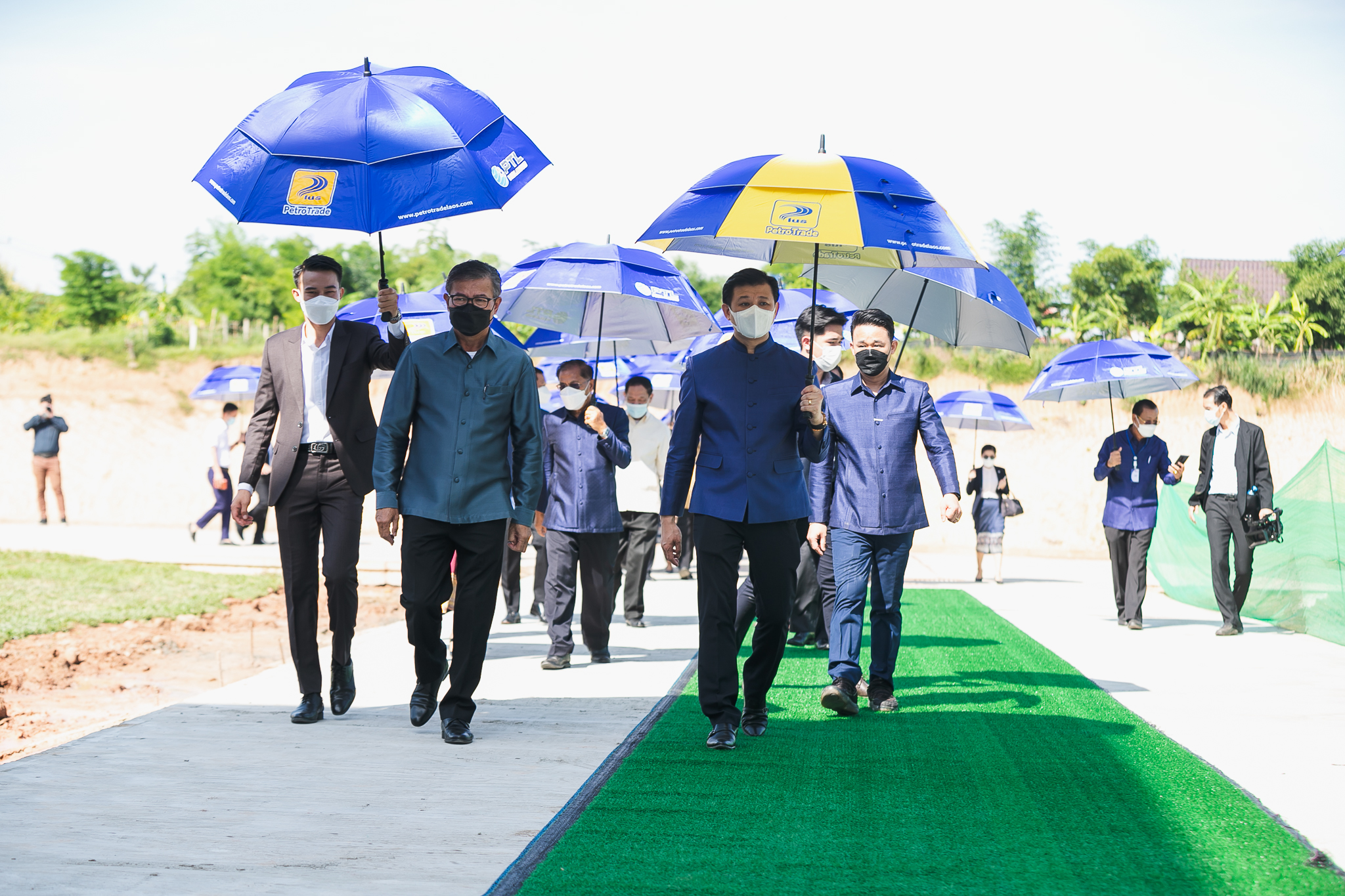
(FROM SECOND LEFT) MR SILA VIENGKEO, MR ALOUNKEO KITTIKHOUN, MR CHANTHONE SITTHIXAY, MR VIENGSAVATH SIPHANDONE AND OTHER OFFICIALS CUT A RIBBON TO LAUNCH THE SOFT OPENING.

The Thanaleng Dry Port (TDP) and Vientiane Logistics Park (VLP) on Tuesday launched a soft opening to pilot the terminal operation system (TOS) to better facilitate transport and related logistics services at the site.
Attending the launch were Minister of Public Works and Transport, Mr Viengsavath Siphandone; Chairman of Vientiane Logistics Park Co., Ltd., Mr Chanthone Sitthixay; former Minister to the Prime Minister’s Office and current President of the Executive Board of Strategy and Planning at PTL Holding Company Limited (PTLH), Mr Alounkeo Kittikhoun; former Deputy Minister of Finance and now Vice President of the Executive Board of Trade and Regulation, PTLH Mr Sila Viengkeo; and other officials and staff.

(FROM SECOND LEFT) MR SILA VIENGKEO, MR ALOUNKEO KITTIKHOUN, MR CHANTHONE SITTHIXAY, MR VIENGSAVATH SIPHANDONE AND OTHER OFFICIALS CUT A RIBBON TO LAUNCH THE SOFT OPENING.
The piloting of the digitalised TOS comes ahead of the planned grand opening of the US$727 million project in November.
Addressing the launch ceremony on Tuesday, TDP Managing Director Sakhone Philangam said the dry port located in Dongphosy village, Hadxaifong district, Vientiane is a first-class international border dry port and offers a wide range of services.
Located near the first Laos-Thailand Mekong Friendship Bridge, the dry port will also serve as a border checkpoint similar to a seaport-based or airport-based transit area or international arrival zone, where procedures are streamlined to enable the free flow of trucks and goods.
Transport information can be provided 24 hours in advance of the transport of goods, which will speed up procedures at the border and save time when crossing the border, according to Mr Sakhone.

A digital information system has been introduced to connect with cargo and transport operators as well as container service providers to facilitate transport and logistics.
The dry port and logistics park are part of the Lao Logistics Link (LLL) project and part of the Lao National Logistics Strategy for 2016-2030, which will boost the government’s efforts to transform Laos from a landlocked into a land-link country.
The dry port, which already connects to the Laos-Thailand railway with a station located inside the port area, is set to link to several trade routes heading to countries in the region and beyond.
One of these links is to the Laos-China Railway, which is scheduled to open for service in December. Through this route, goods transported by rail could reach Germany in just over 10 days.
The dry port is also set to link with a planned railway connecting Vientiane with the Vung Ang seaport in Vietnam’s central Ha Tinh province. Through this route, containers could reach countries and regions such as southern China, Japan, Republic of Korea, Russia, the Philippines and Indonesia.
Speaking at the opening ceremony, Mr Sakhone said the dry port would be Laos’ multi-transport connector and capable of handling as many as 1,000 to 3,000 containers a day.
The TOS has been introduced to manage and operate the dry port and logistics park in parallel with the current system.
The dry port developer believes that use of the TOS will generate confidence among road and rail transport operators as it can handle large volumes of transported goods conveniently and at a reduced cost.

Cross-border transport costs, especially at the Friendship Vientiane-Nong Khai border crossing, are expected to fall by 40 percent from current prices by 2025.
Set to bolster Laos’ hopes of becoming a new global supply chain driven by low transport costs through the use of railways, the dry port developer said Laos could expect to generate huge revenue from the dry port through various charges.
Initially, the target is for at least 300,000 containers from Laos, mainly from the TDP, to be shipped via the Laos-China railway to Europe through China each year. Later, shipments are estimated to rise further to between 1.2 and 1.8 million containers a year, according to the developer.
Mr Viengsavath praised the developer for their efforts to realise the project, with construction now 90 percent complete after just nine months.
The minister pledged that his ministry would continue to support the implementation and operation of the project.
The TDP and VLP, which are being built on a 382-hectare site, are expected to become a new investment destination given the number of incentives offered, including tax breaks and lower logistics costs.
The project comprises five zones offering various opportunities for investors. The zones are as follows:
1. Thanaleng Dry Port (TDP) – the centre of international import and export trade with all categories of customs operations.
2. Tank Farm – a fuel distribution centre for Laos.
3. Logistics Park – a warehousing and distribution centre.
4. Free Trade Zone.
5. Export Processing Zone